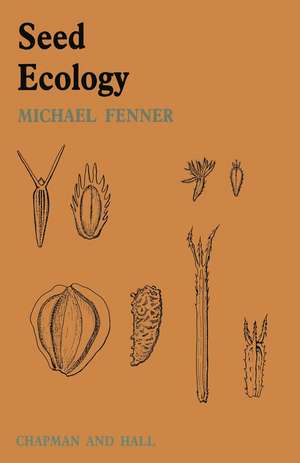Seed Ecology: Outline Studies in Ecology
Autor M.W. Fenneren Limba Engleză Paperback – 31 iul 1985
Din seria Outline Studies in Ecology
- 15%
 Preț: 630.25 lei
Preț: 630.25 lei -
 Preț: 375.07 lei
Preț: 375.07 lei -
 Preț: 375.07 lei
Preț: 375.07 lei -
 Preț: 374.85 lei
Preț: 374.85 lei -
 Preț: 374.85 lei
Preț: 374.85 lei -
 Preț: 375.62 lei
Preț: 375.62 lei
Preț: 378.54 lei
Nou
Puncte Express: 568
Preț estimativ în valută:
72.43€ • 75.83$ • 59.93£
72.43€ • 75.83$ • 59.93£
Carte tipărită la comandă
Livrare economică 05-19 aprilie
Preluare comenzi: 021 569.72.76
Specificații
ISBN-13: 9780412259302
ISBN-10: 0412259303
Pagini: 151
Ilustrații: VII, 151 p. 36 illus.
Dimensiuni: 140 x 216 x 9 mm
Greutate: 0.19 kg
Ediția:Softcover reprint of the original 1st ed. 1985
Editura: SPRINGER NETHERLANDS
Colecția Springer
Seria Outline Studies in Ecology
Locul publicării:Dordrecht, Netherlands
ISBN-10: 0412259303
Pagini: 151
Ilustrații: VII, 151 p. 36 illus.
Dimensiuni: 140 x 216 x 9 mm
Greutate: 0.19 kg
Ediția:Softcover reprint of the original 1st ed. 1985
Editura: SPRINGER NETHERLANDS
Colecția Springer
Seria Outline Studies in Ecology
Locul publicării:Dordrecht, Netherlands
Public țintă
ResearchCuprins
1 Reproductive strategies in plants.- 1.1 Seeds versus vegetative reproduction.- 1.2 The principle of allocation.- 1.3 Reproductive effort.- 1.4 Life histories and fertility schedules.- 1.5 Seed size and number.- 2 Predispersal hazards.- 2.1 Seed losses due to pollination failure.- 2.2 Seed losses due to resource deficiency.- 2.3 Seed losses due to predation.- 2.4 Seed losses due to lethal gene combinations.- 3 Dispersal.- 3.1 Dispersal curves.- 3.2 Dispersal agents.- 3.3 Wind dispersal.- 3.4 External carriage by birds, animals and man.- 3.5 Myrmecochory.- 3.6 Dispersal by frugivory.- 3.7 Long distance dispersal.- 4 Soil seed banks.- 4.1 The seed content of soils.- 4.2 Seed banks in relation to life strategies.- 4.3 Seed longevity.- 4.4 Field longevity experiments.- 4.5 Ecological significance of seed banks.- 5 Dormancy.- 5.1 Ecological significance of dormancy.- 5.2 Types of dormancy.- 5.3 Cyclic changes in dormancy.- 5.4 Influence of parental environment on seed dormancy.- 5.5 Correlative effects.- 6 Germination.- 6.1 The role of gaps in regeneration.- 6.2 Temperature fluctuations.- 6.3 Light quality and periodicity.- 6.4 Microtopography and water relations.- 6.5 The chemical environment.- 7 Seedling establishment.- 7.1 Shade, seed size and seedling growth.- 7.2 Seedling morphology in relation to shade.- 7.3 Competition and seedling survival.- 7.4 Other establishment hazards: drought, burial and predation.- 8 Regeneration and diversity.- 8.1 Coexistence.- 8.2 Gap size.- 8.3 Gap diversity.- 8.4 Timing of disturbance.- 8.5 Environmental fluctuations.- 8.6 Intraspecific spacing.- 8.7 Relative abundance.- References.
Recenzii
`The author has struck an excellent balance between presentations of established facts and introductions to unresolved problems and the result is an introductory text which will do much to commend this fascinating and rapidly-evolving field of research to another generation of biologists.'
New Phytologist
New Phytologist



